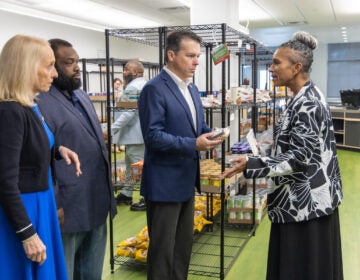Nearly 2 million Pennsylvanians are facing a SNAP funding freeze. Here’s how to find alternative food resources — and how to help
SNAP payments have dried up for nearly 472,000 residents in Philadelphia alone.

File: Crates of milk are seen at a food bnk warehouse on July 2, 2025. (AP Photo/Jeff Chiu, File)
For the first time since the Supplemental Nutrition Assistance Program‘s inception in 1964, payments have been halted across the United States.
SNAP provides food assistance for 42 million people across the U.S. About 1 in 8 Americans rely on the program. Among them are 2 million people in Pennsylvania, with nearly 472,000 recipients in Philadelphia, or roughly 30% of the city’s population.
Nearly 70% of SNAP recipients are children, older adults or people with a disability, according to the U.S. Department of Agriculture.
In Pennsylvania, the SNAP freeze is occurring against the backdrop of the commonwealth’s own budget impasse, which has stalled billions of dollars from going to schools and social services and $25 million in aid from going to food banks. The Pennsylvania budget is currently 121 days past due as of Oct. 29, with no end in sight.
Here’s what to know about November SNAP payments, where to find alternative food resources and how to help.
How long will SNAP payments be frozen?
Federal food aid has not gone out for the month of November amid the government shutdown that began Oct. 1.
President Donald Trump’s administration on Monday said it will partially fund SNAP after a pair of judges’ rulings required it to keep the program running. It remains unclear how much beneficiaries will receive and how quickly recipients’ debit cards may be reloaded.
The Trump administration had argued that the funds were “not legally available to cover regular benefits, a departure from the agency’s shutdown lapse plan, which says “Congressional intent is evident that SNAP’s operations should continue” in the event of a shutdown.
More than two dozen states sued the Trump administration over its refusal to fund food stamps during the shutdown. Delaware Attorney General Kathy Jennings, New Jersey Attorney General Matthew Platkin, and Pennsylvania Gov. Josh Shapiro were among those who signed onto the lawsuit.
Pennsylvania officials expect previously allocated SNAP benefits to remain accessible in November and are telling beneficiaries to save, if able.
Republican and Democratic lawmakers have both introduced bills to keep SNAP funding flowing during the shutdown — one by U.S. Sen. Josh Hawley, of Missouri, and one by U.S. Sen. Ben Ray Luján, of New Mexico — but their passage remains uncertain, as Senate Majority Leader John Thune, of South Dakota, said Republicans won’t allow a piecemeal process.
How else are Philadelphia and Pennsylvania lawmakers responding?
Philadelphia Mayor Cherelle Parker on Saturday launched the “One Philly (SNAP) Support Plan,” allocating $7 million as part of a $14 million regional effort to support residents affected by these “unprecedented conditions,” as the mayor’s office described them.
Under the plan, $4 million will assist food distribution partners, $1.5 million in emergency rental assistance is earmarked toward supporting furloughed federal workers at risk of eviction, and $1 million in reallocated funds will support vulnerable families with food assistance, among other efforts.
Gov. Josh Shapiro on Friday issued a disaster declaration, expediting the delivery of $5 million to food pantries.
The state will distribute funds from the Pennsylvania Emergency Food Assistance Program, Shapiro said, and reallocate reserves from the state Department of Agriculture to help food banks purchase and distribute more food.
Pennsylvania Democratic lawmakers are also pushing for $60 million in emergency aid for food banks and Meals on Wheels programs.
How many people are on SNAP in the Philadelphia region?
As of September, nearly 472,000 Philadelphians receive SNAP benefits, according to Pennsylvania Department of Human Services data. Across the city and its collar counties, nearly 685,000 residents are enrollees, or about 16% of the area’s population.
Next to Philadelphia — where close to one-third of the city’s population relies on SNAP — Delaware County sees the highest percentage of SNAP recipients among Philly’s suburbs, with roughly 75,000 enrollees (13%), compared with more than 46,000 and nearly 63,000 in Bucks and Montgomery counties, respectively (7% each) and over 29,000 in Chester County (5%).
Where can I find alternative free food resources in the Philadelphia region?
A collection of food banks, pantries and related resources can be found by county below:
-
Philadelphia County (search by neighborhood)
-
Bucks County (search by city, borough or township)
-
Chester County (interactive map)
-
Delaware County (search by city, borough or township)
-
Montgomery County (search by city, borough or township)
Other resources
- The Share Food Program offers free food and home delivery for seniors
- Pennsylvanians may use PA Navigate to help find food and other resources
- Local help is also available by calling 211 or visiting PA 211 online
- Philadelphia-based nonprofit Sharing Excess has launched a website mapping free food locations to support people facing food insecurity
- City Councilmember Jamie Gauthier’s office provides free groceries every Thursday starting at noon. West and Southwest Philly residents can call 215-686-0460 for assistance
How can I help Philly-area residents experiencing food insecurity?
A host of state and local organizations — from food banks and pantries to community fridges and grassroots coalitions — are dedicated to fighting food insecurity throughout the Philadelphia region.
Those interested in helping curb food insecurity may donate, volunteer or otherwise partner with any number of related organizations, including the more than 200 that are categorized by county above.
Below is a small handful in the Philadelphia region:
A SNAP funding freeze would follow separate federal cuts and new work requirements. How would food banks be further impacted?
Food banks in Pennsylvania had already been feeling the strain before the federal government shutdown.
The massive tax and spending bill passed by Republicans in July included major cuts to SNAP.
The legislation extended Trump’s 2017 multitrillion-dollar tax cuts and cut Medicaid and food stamps by $1.2 trillion.
The so-called “big, beautiful bill” also included new work requirements for SNAP. Adult recipients under 55 who don’t have children must now prove they work or volunteer at least 20 hours a week. In November, veterans and people between 55 and 64 must also comply with the change.
SNAP eligibility was also removed for some immigrants, including refugees.
Up to 144,000 Pennsylvanians and up to 45,000 Philadelphians risk losing access to SNAP as a result of the recent changes, according to the state.
“We’re worried that many people may lose access to SNAP not because they’re no longer eligible, but because they don’t get the correct piece of paper in and processed at the right time,” Lydia Gottesfeld, an attorney at Community Legal Services of Philadelphia, previously told WHYY News.
Separately, the ongoing government shutdown has left more than 66,000 federal workers in the state without pay.
A surge in demand due to paused SNAP benefits and shutdown furloughs would likely exacerbate existing pressure on local food banks.
Share Food Program, which serves the Greater Philadelphia region, has already had to cut its budget by 20% this year, executive director George Matysik told The Associated Press.
“Any time we have a crisis,” he said, “it’s always the working class that feels the pain first.”
WHYY News’ Zoë Read, WITF’s Jaxon White and The Associated Press contributed reporting.

Get daily updates from WHYY News!
WHYY is your source for fact-based, in-depth journalism and information. As a nonprofit organization, we rely on financial support from readers like you. Please give today.






